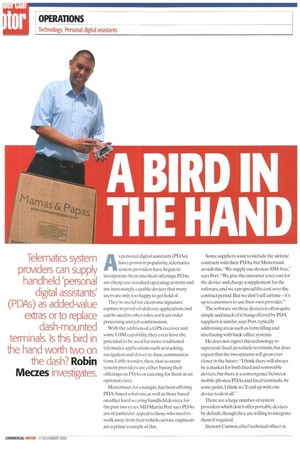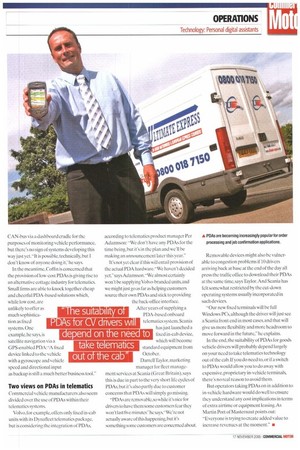A B RD N HE HAND
Page 62

Page 64

Page 65

If you've noticed an error in this article please click here to report it so we can fix it.
As personal digital assistants (PDAs) have gown in popularity, telematics system providers have begun to incorporate them into their offerings. PDAs are cheap, use standard operating systems and are increasingly capable devices that many users are only too happy to get hold of.
They're useful for electronic signature capture in proof-of-delivery applications and can be used in other roles, not least order processing and job confirmation.
With the addition of a GPS receiver and some GSM capability, they even have the potential to be used for more traditional telematics applications such as tracking, navigation and driver-to-base communications. Little wonder, then, that so many system providers are either basing their offerings on PDAs or catering for them as an optional extra.
Masternaut, for example, has been offering PDA-based solutions, as well as those based on other hard wearing handheld devices, for the past two years. MD Martin Port says PDAs are of particular appeal to those who need to work away from their vehicle;service engineers are a prime example of this. Some suppliers want to include the airtime contracts with their PDAs, but Masternaut avoids this. "We supply our devices SI1VI-free," says Port. We give the customer a net cost for the device and charge a supplement for the software, and we can spread the cost over the contract period. But we don't sell airtime—it's up to customers to use their own provider."
The software on these devices is often quite simple and much of it being offered by PDA suppliers is similar, says Port, typically addressing areas such as form filling and interfacing with back-office systems.
He does not expect this technology to supersede fixed, in-vehicle terminals, but does expect that the two systems will grow ever closer in the future: "I think there will always be a market for both fixed and removable devices, but there is a convergence between mobile phones, PDAs and fixed terminals, At some point, I think we'll end up with one device to do it all."
There are a large number of system providers which don't offer portable devices by default, though they are willing to integrate them if required.
Stewart Cannon, chief technical officer at US-based Astrata, explains: "PDAs are not something we supply as standard — we still offer a fixed in-vehicle box— but we do see PDAs as part of a general shift of focus towards more of a service model and we do make them available if that's what the customer wants. Our fixed box is an eighthgeneration device that has a lot more capacity than is currently being used. so there's room for expansion. One avenue we anticipate is to interface to a PDA , with our box as the hub" The trend towards PDAs is changing the nature of the telematics business for many providers. Cannon reports, moving it away from high-cost.proprietary in-vehicle devices to a model where the value lies in the service rather than the hardware.
The value balance is moving heavily towards the service sector," he adds. "The financial model we have is a service model anyway, with no upfront costs.We own the equipment and just lease it to customers with a monthly service charge.The PDA is not an expensive component and can easily be fitted into the cost of that."
Like Port. Cannon doubts that PDAs will ever take over completely from fixed devices for the simple reason that many users want telematics systems to help them manage vehicles, as well as business processes."At some point in vehicle telematics, you have to be tied to the vehicle," he adds."For example, if you want a system to tell you when a trailer door is opened."
Need for fixed communications Its a similar story at C■ hit where UK sales director John Wisdom says that while handheld devices clearly have a role to play— electronic signature capture being the main one —there's an unavoidable need for communications to be fixed to the vehicle if it's the vehicle users want to manage.
If the device is fixed it means it can't get lost or broken," he points out. "And there are still some challenges when it comes to adding GPS to a handheld device for applications like vehicle tracking— if the driver decides to turn it off, for example. Rut where a device is fitted to the vehicle it displays all aspects of where it is and what it's doing."
PDAs are very much geared towards users in the service engineer sector, says Wisdom. The main application in this sector is to interface to back office systems, though, ironically perhaps, this is often done via the fixed on-board device.
"It's all about taking information from the PDA and sending it back to a customer's back office system through the in-vehicle telematics unit," he says, and this is why Cybit doesn't supply PDA hardware.
Siemens VDO does offer a PDA-based solution, but not as standard. Steve Coffin, general manager, fleet systems, explains that although PDAs are a very flexible piece of kit, they're not really designed for automotive applications: "There are some ruggedised PDAs about, but most are not designed for industrial applications. By and large they're still a bit of an executive toy... and if you want to monitor or track a vehicle you really need something on the vehicle itself."
He concedes that in the future it might he possible to connect PDAs to the vehicle's CAN-bus via a dashboard cradle for the purposes of monitoring vehicle performance, but there's no sign of systems developing this way just yet. '1t is possible, technically, but I don't know of anyone doing it,' he says.
In the meantime, Coffin is concerned that the provision of low-cost PDAs is giving rise to an alternative cottage industry for telematics. Small firms are able to knock together cheap and cheerful PDA-based solutions which, while low cost, are unlikely to offer as much sophistication as fixed systems. One example, he says, is satellite navigation via a GPS-enabled PDA:"A fixed device linked to the vehicle with a gyroscope and vehicle speed and directional input as backup is still a much better business tool."
Two views on PDAs in telematics
Commercial vehicle manufacturers also seem divided over the use of PDAs within their telematics systems.
Volvo, for example, offers only fixed in-cab units with its Dynafleet telematics package, but is considering the integration of PDAs. according to telematics product manager Per Adamsson: "We don't have any PDAs for the time being, but it's in the plan and we'll be making an announcement later this year."
It's not yet clear if this will entail provision of the actual FDA hardware."We haven't decided yet," saysAdamsson."We almost certainly won't be supplying Volvo-branded units, and we might just go as far as helping customers source their own PDAs and stick to providing the back-office interface.
After years of supplying a PDA-based onboard telematics system, Scania has just launched a fixed in-cab device, which will become standard equipment from October.
DarrellTaylor, marketing manager for fleet management services at Scania (Great Britain),says this is due in part to the very short life cycles of PDAs, but it's also partly due to customer concerns that PDAs will simply go missing.
"PDAs are removable,so while it's nice for drivers to have them some customers fear they won't last five minutes" he says."We're not actually aware of this happening. hut it's something some customers are concerned about. Removable devices might also be vulnerable to congestion problems if 10 drivers arriving back at base at the end of the day all press the traffic office to download their PDAs at the same time,says Taylor. And Scania has felt somewhat restricted by the cut-down operating systems usually incorporated in such devices, "Our new fixed terminals will be full Windows PCs, although the driver will just see a Scania front end in most cases, and that will give us more flexibility and more headroom to move forward in the future," he explains.
In the end, the suitability of PDAs for goods vehicle drivers will probably depend largely on your need to take telernatics technology out of the cab. If you do need to, or if a switch to PDAs would allow you to do away with expensive, proprietary in-vehicle terminals, there's no real reason to avoid them.
But operators taking PDAs on in addition to in-vehicle hardware would do well to ensure they understand any cost implications in terms of extra airtime or equipment leasing. As Martin Port of Masternaut points out: -Everyone is trying to create added value to increase revenues at the moment." in






































































































































































































